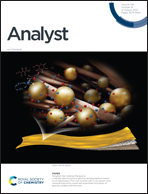A portable molecularly imprinted polymer-modified microchip sensor for the rapid detection of perfluorooctanoic acid†
Abstract
High-performance electrochemical sensors have attracted intensive interest in real-time environmental safety monitoring, the Internet of Things, and telemedicine applications. A key limitation to field measurement of pollutant distribution is the lack of a highly sensitive and selective monitoring platform, thus severely hindering the decentralized monitoring of pollutant exposure risk. Hence, a sensor was developed in this study by using a molecularly imprinted polymer (MIP). Specifically, Cu2O@C@NiCo2O4, with a large surface area and high conductivity, was coated onto the Au electrode surface and further modified by the anodic electro-polymerization of o-phenylenediamine (o-PD) using perfluorooctanoic acid (PFOA) as the template, followed by template removal for activation, thus obtaining the Au/Cu2O@C@NiCo2O4/MIP electrode. Particularly, an effective monitoring platform derived from this sensor was designed to achieve cost-effective pollution detection. Au/Cu2O@C@NiCo2O4/MIP was employed in a disposable microchip sensor for the sensitive detection of PFOA, exhibiting an ultra-low limit of detection (LOD) of 19.46 ng L−1 in a linear range of 207–4140 ng L−1 along with satisfactory sensitivity, selectivity, and reproducibility, which reveal its great potential in the low-cost and efficient field detection of PFOA in coastal seawater. These promising results indicate a bright future for such microchip-sensor-supported PFOA tele-sensing platforms in aiding environmental safety and blue earth protection. We will persist in refining this method to enhance the sensitivity of the sensor for PFOA detection in polluted coastal areas.



 Please wait while we load your content...
Please wait while we load your content...